 Sunday/Weekend
Sunday/Weekend

by Công Thành
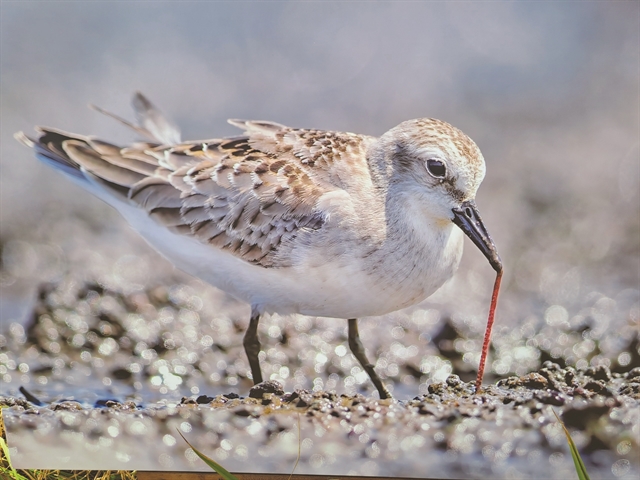 |
| A seabird seeks food at a beach in central Việt Nam. Photo courtesy of Võ Rin |
Aged 40, Võ Rin's love for photography started late, but snapping migratory wild birds fascinates the Hội An-born freelancer.
Rin has left his footprints at almost all national parks and natural reserves nationwide, collecting masses of photos of endangered species of migratory birds, while providing info for bird conservation and interior decoration for resorts and hotels.
“It’s really a waste of money, as I spent time and cash on long treks in the forest seeking photos of rare bird species in large reserves,” Rin said.
“But I earn money from regular photography, so snapping photos of endangered bird species in the jungle is just an amazing hobby for me.”
Rin said bird photographers miss impressive moments if they lose concentration, as wild birds could likely never repeat their beat.
“Bird cameramen often disguise themselves in nature with jungle camouflage and gentle actions. Birds can feel the danger from the appearance of bigger animals in nature,” he said.
Rin recalled that he missed a photo of a crested argus (Rheinardia ocellata) in a forest 600m above sea level in Quảng Nam Province as the bird felt the echo of footsteps on the ground.
“It means I have to walk barefoot instead of shoes when taking photos of the birds," he said.
Rin recently paid for a 21-day trip to take a full collection of a seabird laying eggs on a sandy beach in Cửa Đại of Hội An City.
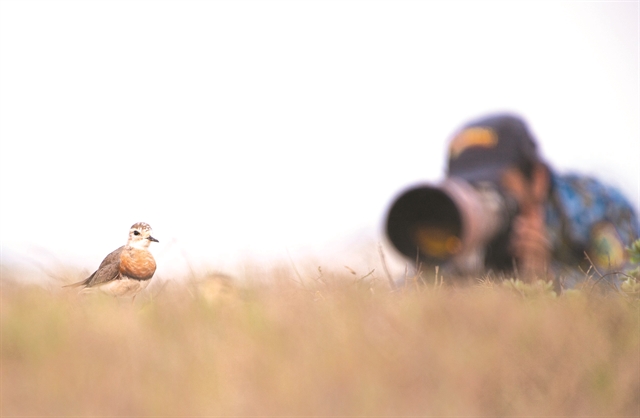 |
| A bird photographer takes a picture of a bird in a field. Photo courtesy of Phạm Tài Minh |
The bird found a really safe place, isolated on the beach and no dangerous predators could approach due to the scorching temperature, he explained.
“The mother bird sometimes flew to get its feathers wet to cool the hatched eggs. I followed its actions from morning to evening, taking photographs.”
Đỗ Doãn Hoàng, a journalist and a member of the Việt Nam Bird Conservation Society (VBCS), said Rin’s bird photo trips derived from a love of nature and the beauty of birds.
“It’s an expensive hobby. He makes his life from architecture photography and decoration to nurture his love of bird watching,” Hoàng said.
“From having zero experience of bird species, Rin has been growing knowledge and understanding of birds, and he could serve as an experienced guide to bird landing sites in central Việt Nam.”
Bird protection
Naturally, almost all wild bird photographers combine their art with conservation during their adventures in the jungle or at public sites, usually at spots where the birds find peace and safety, or stop to get food on long migratory journeys.
Removing snares or net traps set by poachers is common to all members of the VBCS, according to Phạm Tài Minh, a member in central Việt Nam.
“We persuade poachers to remove traps at sites where migratory bird species often stop over during their journeys to warmer areas. Bird photographers call for eliminating bird hunting by snares everywhere they go, or ring to rangers and security forces for trap dismantlement,” Minh said.
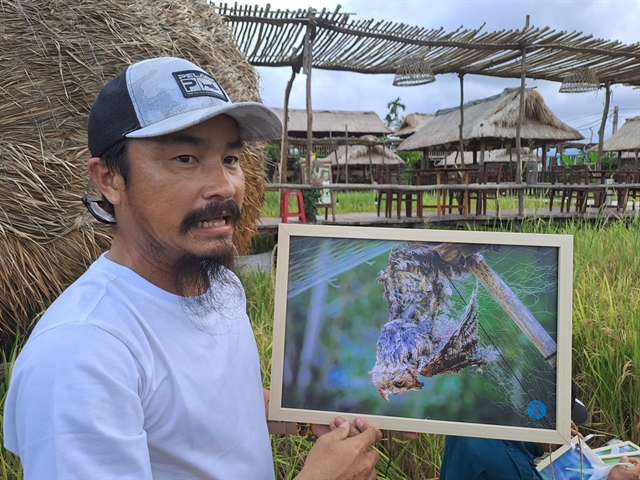 |
| Freelancer Võ Rin shows his photo of a bird in a net trap. Hunting birds for pets and food is often seen in central Việt Nam. VNS Photo Công Thành |
He added that net-traps accounted for about 80 per cent of violation cases found by volunteers and bird cameramen.
“We recently dismantled 600m of bird net -- the longest one that we have ever witnessed – in central Việt Nam. The beach areas of Đà Nẵng and Hội An naturally became stops for migratory birds, but rapid urbanisation has narrowed the areas of sandy beaches and swamps,” Minh said.
“Migratory birds cannot recognise the change brought by new apartments or resorts when they return to have stopover at where were once food-rich habitats.”
He said bird net traps were commonly used by those seeking money from pet shops.
“Poachers can earn VNĐ400,000 (US$16) from a bird-netting trip, while payment for snares is cheap and easy,” Minh said. “The hunters set up net-traps with bait and wait. Hundreds of birds can be trapped in a few hours."
Minh, also a lecturer at the University of Đà Nẵng, warned that tiny "blind nets" were the most dangerous as birds could not recognise the net when flying.
He said they could even lead to the extinction of several bird species.
A field survey from a conservationist group at the university reported that some endangered species of migratory birds had been regularly recorded on beaches, river banks and vacant land plots in Đà Nẵng and Hội An in 2018-20.
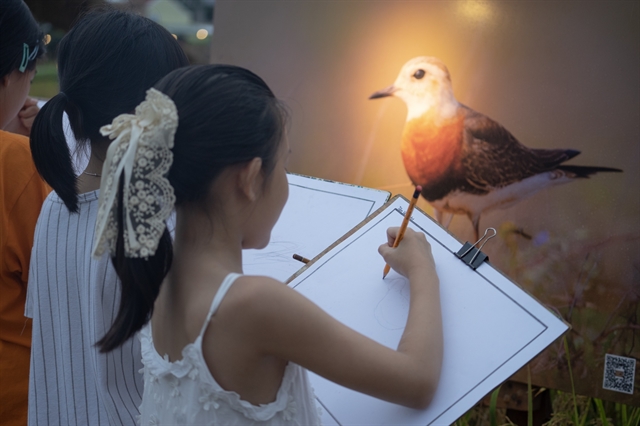 |
| School students join a painting experience event at an exhibition of wild bird species in Hội An City. Freelance photographers join hands to help children understand bird protection. Photo courtesy of Võ Rin |
“Coastal areas in Đà Nẵng and Hội An are safe stops for migrant birds, including many endangered species, and an attraction for tourists and international conservation organisations,” Minh said
Rin said he believed raising awareness among the young and local residents is critical to improving things.
“Education programmes on wildlife and bird protection for school students, local fishermen and residents will help improve the conservation of endangered bird species,” Rin said.
“I organised two exhibitions on migratory birds at Hội An City’s Chic Chillax – a paddy-field café and check-in site – to spread messages on bird conservation. Communication on bird protection at schools is needed, so students will become the future guardians of the birds.”
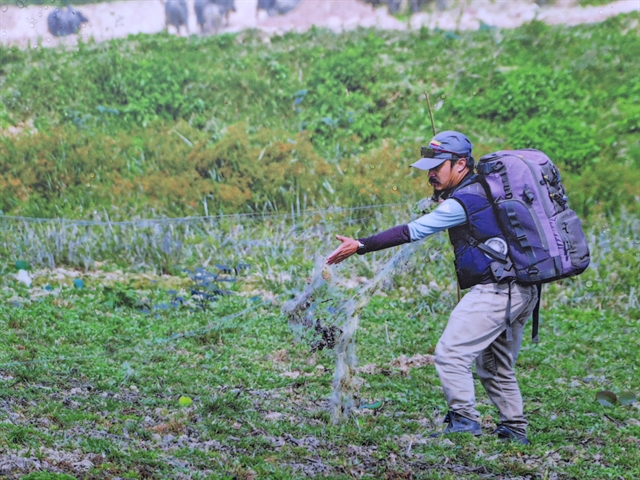 |
| Võ Rin removes a bird net trap during a bird photo trip in central Việt Nam. Freelance photographers themselves dismantle snares and bird traps nationwide. Photo courtesy of Võ Rin |
Members of the VBCS in central Việt Nam have been building observation towers on Cửa Đại beach in Hội An to record appearances of migratory birds at the site.
“It will help build up our database for research and conservation of birds in central Việt Nam, calling for protective actions from local residents and authorities,” Rin said.
“About 20 or 30 groups of freelance bird photographers are working nationwide, widening the network of bird conservation in the country.” VNS




